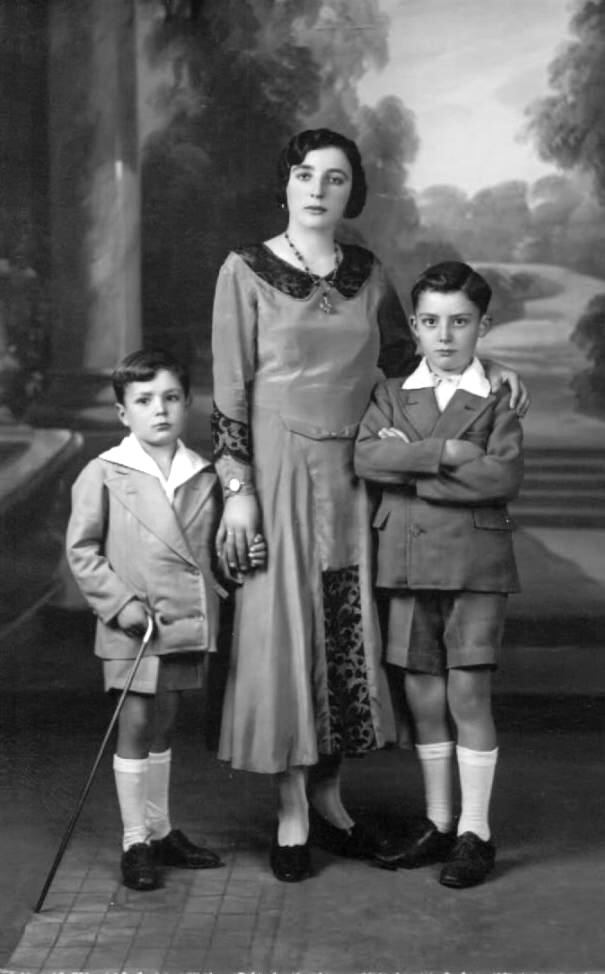
Argentine Boys Suits: Garments

Figure 1.-- This Argentine studio portrait shows a mother with her two sons. The boys look to be about 5-10 years old. Both boys wear double-breasted short pants suits with knee socks. Note the open sports coolars. The portrait is undated, but looks like the 1930s.
|
|
Several different garments make up suits. The basic and most important suit garments are jackets and pants. Occassional caps and more commonly vests are also suit garments. The stypes and styles of these garments varied over time. We notice boys wearing various jacket styles. We have little informtion on the jacket styles popular in the 19th century like the cut-away jcket. We note Norfolk as well as single and double breasted jackets in the early-20th century, but single-breasted blazers became more common in the later half of the century. We see younger boys wearing sailor suits. British and European styles seem more important than American styles. Knee pants and short pants were very common for boys. Until about 1930, long stockings were common, especially for older boys. Gradually knee socks became more popular. Knickers were much less common. We see some boys wearing knickers, but they do not seem very common. less common. Long pants suits became more common after mid-century, although suits were becoming less common by the 1970s.
Headwear
We notice boys wearing various jacket styles. The style of the jacket or coat basically determined the suit style. Mos suits were worn with various types of pants, but this did not affect the suit style. We see the same jacket styles that were worn in Europe and the United States, although our archive is limited at this time. We have no infomation on the 18th and early-19th century. We have no information on the skelton suit which appeared in the late-18h century, but assume tht boys from families in confortable circumstances wore them. We have some limited information on the second-half of the 19th century. We see Argentine boys wearing cut-away jackets and other popular styles including sack suits and various lapel jackets, We do not yet have examples, but we believe Argentine boys wearing collar0-buttoning jackets. We note Norfolk as well as single and double breasted jackets in the early-20th century. Here we see boys wearing double-breasted jackets in the 1930s (figure 1). Single-breasted blazers became more common in the later half of the century. We see younger boys wearing sailor suits. British and European styles seem more important than American styles. Stylistic details like lapel width seem to follow European trends. American fashions seem to become more important after World War II. And as in America and Europe, we see fewer boys wearing suits by the 1970s.
Vest
Many suits were done with vests in the 19th and early-20th century. The major exception was the collar-buttoning jacket in which a vest could not be seen. In the 20th century, after World War I (1914-18) we begin to see fewer vested suits.
Pants
Knee pants and short pants were very common for boys. Until about 1930, long stockings were common, especially for older boys. Gradually knee socks became more popular. Knickers were much less common. We see some boys wearing knickers, but they do not seem very common. less common. Long pants suits became more common after mid-century, although suits of all kinds at the same time were becoming less common by the 1970s.
HBC

Navigate the Boys' Historical Clothing Web Site:
[Return to the Main Argentine garment suit page]
[Return to the Main Argentine garment page]
[Return to the Main country suit page]
[Return to the Main country hosiery page]
[Return to the Main Argentine page]
[Introduction]
[Activities]
[Biographies]
[Chronology]
[Clothing styles]
[Countries]
[Bibliographies]
[Contributions]
[FAQs]
[Glossaries]
[Images]
[Links]
[Registration]
[Tools]
[Boys' Clothing Home]
Created: 7:03 AM 8/29/2011
Last updated: 3:10 PM 2/2/2015



